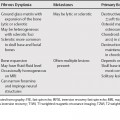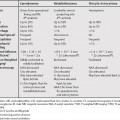138 There are numerous etiologies of increased signal in the rotator cuff on magnetic resonance imaging (MRI) not related to a full-thickness tear. Increased signal (isointense to muscle) can be seen in the supraspinatus tendon in asymptomatic individuals on short echo time (TE) images. On long TE images, this signal resolves or remains isointense to muscle. This can be distinguished by its characteristic location and appearance. It occurs 5–10 mm proximal to the greater tuberosity insertion, is round or oval and ~8 mm in diameter.1 This may be multifactorial in origin, and contributing factors include magic angle effect, partial volume averaging, and early degeneration in a vascular watershed region.2–4
Increased Signal in the Rotator Cuff Not Related to Full-Thickness Tear
Stay updated, free articles. Join our Telegram channel

Full access? Get Clinical Tree





